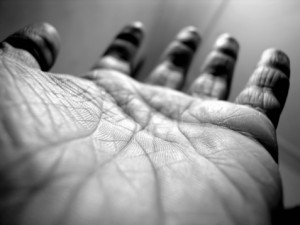Out of Touch (Part 1)
By Asher Crispe: June 4, 2012: Category Decoding the Tradition, Inspirations
A Phenomenology of Involvement without Interference in the Rabbinic and Philosophic Traditions
—A hand that extends itself, that refuses itself, that we cannot take hold of in any way.
Maurice Blanchot (1)
—All the work of the hand is rooted in thinking.
Martin Heidegger (2)
(The Beginnings of a Sketch…)
 Any examination of the subject of human contact, the sense of touch in general, and the custom of shaking hands in particular, is bound to be pressured to include a vast circle of philosophic friends whose roundtable discussion ignites a fire at its center. What we intend on studying is a rabbinically sponsored sociological phenomenon of limiting physical contact between the sexes—a phenomenon that resists many of the cultural conventions of today.
Any examination of the subject of human contact, the sense of touch in general, and the custom of shaking hands in particular, is bound to be pressured to include a vast circle of philosophic friends whose roundtable discussion ignites a fire at its center. What we intend on studying is a rabbinically sponsored sociological phenomenon of limiting physical contact between the sexes—a phenomenon that resists many of the cultural conventions of today.
Often depicted as a question of the handshake or the refusal of the contact that it entails, the prohibition in classical rabbinic texts has yet to show its full face. “Orthodox” observance of this injunction (as applicable contextually both in and out of marital and familial bonds) may stand as emblematic of greater counter-cultural tendencies. We hope that this examination entails more than a cry for help from the philosophic community to put a fresh spin on a sedentary practice. On the other hand, we must let go of old assumptions that this form of forbidden touch represents merely a flat, colorless play in the greater game of social etiquette, quest for sanctity, and religious fanaticism.
Gestures, we may decide, mean more than they mean, even when they are absent.
While sources, both mystical and rational, ancient and modern, are required to “open” this withheld gesture, these reflections may at best be taken as a general outline of experiences both strange and familiar.
British comedy legends Monty-Python have satirized the over-indulgent handshake in at least one sketch. Pulling out all the stops, we witness the freakish frenzies of slightly silly secret shakes and other odd and uncommon greeting techniques such as the rubbing of noses as the touchstone in their rendering of an absurd society. When we pause to think about it, many of the most common activities, including the all-too-proper handshake, lose their innocence.
We are accustomed to this most basic act of straightforward simplicity. We have assumed that manners create and preserve the distance between the human and the animal. Without decorum we would dissolve the basic fabric of civilization and degenerate into savages. The point being, who knows the where-from and why of this staple mode of greeting and interaction? Commenting on the shrouded origins of the handshake, José Ortega Y Gasset offers what could be a part of a widespread confession in the public lives of many individuals:
For it turns out that this action of mine of taking people’s hands and giving them my own, an action that I did not premeditate performing when I went to the gathering, not only did not occur to me nor proceed from my wish, but despite its being so elementary, utterly simple, frequent, and habitual, I do not even understand it. For in fact I do not know why I do it because I know that if I do not give my hand to others, if I do not greet them in this fashion, they will think me ill-mannered, disdainful, proud, and so on. (3)
Moreover, he has no one to blame for this condition that he is subjected to—that is, no one in particular. Gasset has hit upon the “they-self” of the fallen inauthentic person in the Heideggerian sense, especially as he persists in his examination of anonymous social conditioning: “Now, the ‘usual,’ the customary is something that we do because it ‘is done.’ But who does what ‘is done’? Why, people. Very well—but who are ‘people’? Why, everybody and, at the same time, no one in particular.” (4)
Thus he transforms the ordinary into a strange and unfamiliar object whose pursuit propels us further and further away from the “usual”—the “usual” being that which forswears thoughts of self-alienation while enjoying the comfort of swimming with the stream.
Continuing to develop the spirit of compromise that swells as the side-effects of the handshake, Gasset offers the following assessment:
…I know very well that the love takes fraudulent advantage of the occasion of the handshake to thrill with delight by causing the skin of his hand to feel the warmth from the skin of another hand. But this pleasure is not a pleasure of the salutation—which is no pleasure at all—but on the contrary is a fraud that we perpetrate on it, an abuse of that usage, the salutation. I do not know how it happens that love always displays a most fertile inspiration in fraud and behaves like a clever smuggler who never lets an opportunity slip. But the same lover is perfectly well aware that the salutation is no delight, since usually the delight of touching the beloved hand is purchased at the cost of having to squeeze several or many other hands, some of them annoyingly sweaty. For him, too, salutation is an operation that is performed perforce. (5)
 We can bank on a certain degree of self-satisfaction acquired at the risk of untended awkwardness. The unconscionable erotic pleasure from the hand of the intended displaces its surface intent. Willingness to pay the premium of mild discomfort in other undesirable circumstances somehow balances the budget of interpersonal behavior in the average person’s account. Perhaps we can assert as Gasset has that “…shaking hands has a meaning because that was how they assured each other that they were not carrying weapons in their hands.” (6) The only modification worth adding to this would come after ascertaining if these weapons were solely of steel or if they could include weapons of flesh. Could it be that the hand itself is a weapon? It certainly is a consistent symbol of power.
We can bank on a certain degree of self-satisfaction acquired at the risk of untended awkwardness. The unconscionable erotic pleasure from the hand of the intended displaces its surface intent. Willingness to pay the premium of mild discomfort in other undesirable circumstances somehow balances the budget of interpersonal behavior in the average person’s account. Perhaps we can assert as Gasset has that “…shaking hands has a meaning because that was how they assured each other that they were not carrying weapons in their hands.” (6) The only modification worth adding to this would come after ascertaining if these weapons were solely of steel or if they could include weapons of flesh. Could it be that the hand itself is a weapon? It certainly is a consistent symbol of power.
Offered in the right way, the grip of the hand underwrites trust and confidence. Offer it in a manner that is only slightly different and it will arouse suspicion. Add into the equation the issues of gender and sexual politics attached to the other end of the hands in question and let the circus begin. Here, we see the gestures of a self-same organ stir up feelings of conquest and violation, attraction and desire. Fidelity and betrayal are marked by virtually imperceptible moments of the exchange. And we are all beholden to convention. Cultural considerations weigh upon us even as they change with the passing of time. Is it proper for men and women to shake hands? Responses to this question will range depending on the cultural milieu to which it is addressed.
Writing about sexual differences in salutations, Ashley Montagu, long time champion of progressive social psychology, cites shifting customs in the Western world where for example, there was a time when “Men do not shake the hands of women, but bow, unless the woman extends her hand, when in the English-speaking world it will be shaken, and in the Latin-speaking world kissed.” (7)
Classical rabbinic literature would appear to have taken a more radical view that has in some circles remained largely unaltered for a considerable time, resisting the temptation to follow after the current trends of the larger societies within which those Jewish authorities and their communities lived and continue to live. Let us be clear that the present work is not in any way attempting to engage the historical character of this custom nor to survey the extent of its observance, but rather to cite it as a possibility ripe with meaning in a broader discussion of the phenomenology of touch. (8)
To “fall” out-of-touch seems inevitably tied to assumptions about the female body. While it may remain to be seen that the female body is really just the body which is female, that is, the container of the human subject, the house of the soul, the vessel, which is the receiver of all contact, we can nonetheless address our concerns first as a male subject (even though this will hopefully prove to be the “relatively” masculine as opposed to an absolutely male subject). Gasset, in his analysis, attempts to justify the greater sensitivity of female embodiment:
The comparative hyperesthesia of women’s organic sensations brings it about that her body exists for her more than man’s does for him. Normally, we men forget our brother the body; we are not aware of possessing it except at the chill or burning hour of extreme pain or extreme pleasure. Between our purely psychic I and the outer world, nothing seems to be interposed. Woman, on the contrary, is constantly having her attention claimed by the liveliness of her intracorporeal sensations; she is always aware of her body as interposed between the world and her I, she always carries it before her, at once as a shield of defense and a vulnerable hostage. The consequences are clear: women’s whole psychic life is more involved with her body than man’s; in other words, her soul is more corporeal—but, vice versa, her body lives more constantly and closely with her spirit; that is, her body is more permeated with soul. In fact, the feminine person displays a far higher degree of interpenetration between body and spirit than man. In man, comparatively speaking, each normally takes its own course; body and soul know little of each other and are not allied, rather, they act like irreconcilable enemies. (9)
From this can we assume that Gasset would place safeguards around the “vulnerable hostage” so that in “touch,” the female body may not be reduced to a mere body. The exposure to touch as an unsolicited invasion of foreign interests would chalk up to its counterpart in the objectifying state. Draining the body that received that stare or felt that touch of its “psychic life” would be tantamount to extracting “her spirit” and denying a body “more permeated with soul.” Following a similar logic, we might issue a condemnation of the male, who, estranged from his own body in Gasset’s account, preys upon the indwelling soul of the female in an attempt to more fully persuade himself that his own fugitive soul is an “irreconcilable” enemy of his body. He would create for her what he lacks for himself. The de-feminization of the body entails the exile of the soul or at least a more noticeable discord between soul and body.
Flipping over to the other extreme, we see that Gasset’s account fails to capture the positive side of the handshake. For this we require a little help from Emmanuel Levinas for whom the possibility of this gesture bathed in an ethical light begs the question: “Is the handshake not, then, an attuning of oneself to the other, a giving of oneself to him or her?” (10)
 To which we might respond that this “giving of oneself” is, at times, an involuntary giving—even a giving up of self to the other, a loss of self, a violation and a violence. Yet, Levinas surely is seeking the handshake in its first light prior to any corruption or in a refashioned rectified sense where sexual politics has no place. Attunement to the other in the form of a gift of oneself strikes a chord in the heart of hospitality. Nonetheless, a faint odor of idealism lingers here, a longing for a new/old world order of Edenic proportions where such gifts may be granted without reservation or negotiation. Gasset occupies the role of the realist embracing the harshness of current reality and staying its course. Could we place them as the philosophies of exile (Gasset) and redemption (Levinas)? Intertwined as possibilities, does not the exchange of contact between people carry the simultaneous potential to engage or disengage the inner spirit, to spiritualize or to objectify?
To which we might respond that this “giving of oneself” is, at times, an involuntary giving—even a giving up of self to the other, a loss of self, a violation and a violence. Yet, Levinas surely is seeking the handshake in its first light prior to any corruption or in a refashioned rectified sense where sexual politics has no place. Attunement to the other in the form of a gift of oneself strikes a chord in the heart of hospitality. Nonetheless, a faint odor of idealism lingers here, a longing for a new/old world order of Edenic proportions where such gifts may be granted without reservation or negotiation. Gasset occupies the role of the realist embracing the harshness of current reality and staying its course. Could we place them as the philosophies of exile (Gasset) and redemption (Levinas)? Intertwined as possibilities, does not the exchange of contact between people carry the simultaneous potential to engage or disengage the inner spirit, to spiritualize or to objectify?
1 Maurice Blanchot The Step Not Beyond. P.106 (Also quotes in Levin p.370).
2 What is Called Thinking? P.16.
3 Man and People. P.187.
4 Ibid. p.182.
5 Ibid. p.190.
6 Ibid. p.197.
7 Touching: The Human Significance of Skin. P.362.
8 For some references in rabbinic literature to the prohibition of contact between the sexes outside of the bounds of marriage and family as well as inside the bond of marriage where the restriction extends to the time of menstruation see Netei Gaveriel: Hilchot Yicud chapter 52 on the אסור הנגיעה והושטת יד לאשה. Of note are the exceptions of medical and other health-related cases where the standard restrictions don’t apply. Again, our concern here is not with a Halakic discussion. Rather, we are content to highlight the mere fact that this is an issue of consideration which re-sensitizes us to the dynamics of the handshake and other forms of causal contact where the gendered nature of that contact threatens to displace what is often assumed to be the underlining ethical offering to the other embodied in those gestures. The hyperbolic statements of the Midrash suggest the singling out of the slightest of touch to underscore its most dramatic possibilities, where one who looks at the small finger of a women (presumably in a self-grafting and objectifying way) is considered to have gazed at her most private parts. Likewise, small, seemingly insignificant contact also bears comparison with touching the most intimate part of a woman. Vision and touch when in the mode of gathering sensations that forge representations of the other depleted of soul, acquisitions made for personal gain, open the vortex of omni-sexual possibilities springing from every encounter. In the original locution of the Yalkut Shimoni Remez 786 (Bamidbar): “עד כל המסתכל באצבע קטנה של אשה כאלו המסתכל במקום התורף” as well as “כל הנוגע באצבע קטנה של אשה כאלו נוגע באותו מקום”.
In a somewhat more “Midrashic” mode, we can entertain the idea that every אסור [(issur)prohibition] be understood as אסר (assar), an imprisonment, a locking up of some potential. It can also mean to tie or to bind implying the connection of disconnection—a theme revisited in innumerable drashot of Chassidic thought. Thus, the אסור הנגיעה [prohibited touch] might suggest the refusal of touch in touch—touching in a manner that is not touching at all. This idea we hope to explore further with attention to the philosophic echoes throughout the generations. With regard to the second phrase הושטת יד לאשה [extending a hand to a woman] we might argue that the terms אשה [woman] enjoys a larger definition than that anchored in a biological female.
Kabbalistic literature is replete with references to the term אשה [woman] as the designation for any recipient or מקבל [mikabel]. The focus then may well turn to all who receive my extended hand and whether that hand is welcome under all circumstances or whether it should be held in reserve. The basic suggestion that will have to be left for further study revolves around the willingness to accept rabbinical ordinances and the resultant social customs as tropes for a wider index of interactions: spiritual, intellectual, and social, springing from average everyday physical regiments. For those accustomed to reading the legalistic literature of rabbinic Judaism in such a way, these speculations are no great stretch.
9 Man and People. P.137. This description underscores an element of the rabbinic restrictions on touch as “הושטת יד לאשה. [extending a hand to a woman]”
10 “In Memory of Alphonse de Waelhens” p.112 in the volume of essays Outside the Subject.
http://www.interinclusion.org/inspirations/out-of-touch-part-2/
Out of Touch (Part 1),























;)
;)
;)
;)
;)
;)
;)
;)
;)
;)

Sometimes a handshake is just a handshake.